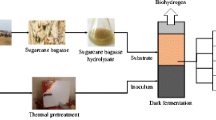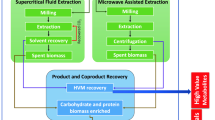Abstract
New substrates and fermentation conditions have been drawing researchers’ attention to increase the bioethanol productivity. The aim of this study was to evaluate the acid hydrolysis of Spirulina biomass and its use in association with molasses in ethanol production with and without magnetic field (MF) application. Hydrothermal hydrolysis of Spirulina biomass hydrolysis was evaluated. The highest reducing sugar concentration (79% w w−1) was obtained with sulfuric acid 5% (v v−1), 121 °C, 30 min, and 500 g L−1 of biomass. This hydrolyzed biomass and molasses were used as substrates in the alcoholic fermentation with Saccharomyces cerevisiae by varying the biomass/molasses (B/M) ratio: 25, 50, and 75% (v v−1). The medium 25% B/M had higher ethanol yield at 78.9% and productivity of 0.72 g L−1 h−1. MF application did not increase the cell growth and ethanol production. This is the first study that integrates molasses and microalgal biomass substrates for ethanol production and presents some new information about magnetic fields application that is still little explored in the literature.
Graphic Abstract



Similar content being viewed by others
References
Oey, M., Sawyer, A.L., Ross, I.L., Hankamer, B.: Challenges and opportunities for hydrogen production from microalgae. Plant Biotechnol. J. 14, 1487–1499 (2016). https://doi.org/10.1111/pbi.12516
Jiang, X., Guan, D.: Determinants of global CO2 emissions growth. Appl. Energy. 184, 1132–1141 (2016). https://doi.org/10.1016/j.apenergy.2016.06.142
Tollefson, J.: Global industrial carbon emissions to reach all-time high in 2018. Nature (2018). https://doi.org/10.1038/d41586-018-07666-6
Hossain, M.N.B., Basu, J.K., Mamun, M.: The production of ethanol from micro-algae Spirulina. Procedia Eng 105, 733–738 (2015). https://doi.org/10.1016/j.proeng.2015.05.064
Guo, M., Song, W., Buhain, J.: Bioenergy and biofuels: history, status, and perspective. Renew. Sustain. Energy Rev. 42, 712–725 (2015). https://doi.org/10.1016/j.rser.2014.10.013
Şerbetçioğlu Sert, B., İnan, B., Özçimen, D.: Effect of chemical pre-treatments on bioethanol production from Chlorella minutissima. Acta Chim. Slov. 65, 160–165 (2018). https://doi.org/10.17344/acsi.2017.3728
Muruaga, M.L., Carvalho, K.G., Domínguez, J.M., de Souza Oliveira, R.P., Perotti, N.: Isolation and characterization of Saccharomyces species for bioethanol production from sugarcane molasses: studies of scale up in bioreactor. Renew. Energy. 85, 649–656 (2016). https://doi.org/10.1016/j.renene.2015.07.008
He, J., Wu, A.M., Chen, D., Yu, B., Mao, X., Zheng, P., Yu, J., Tian, G.: Cost-effective lignocellulolytic enzyme production by Trichoderma reesei on a cane molasses medium. Biotechnol. Biofuels. 7, 1–9 (2014). https://doi.org/10.1186/1754-6834-7-43
Markou, G., Angelidaki, I., Nerantzis, E., Georgakakis, D.: Bioethanol production by carbohydrate-enriched biomass of Arthrospira (Spirulina) platensis. Energies. 6, 3937–3950 (2013). https://doi.org/10.3390/en6083937
Sivaramakrishnan, R., Incharoensakdi, A.: Utilization of microalgae feedstock for concomitant production of bioethanol and biodiesel. Fuel 217, 458–466 (2018). https://doi.org/10.1016/j.fuel.2017.12.119
Farias Silva, C.E., Bertucco, A.: Dilute acid hydrolysis of microalgal biomass for bioethanol production: an accurate kinetic model of biomass solubilization, sugars hydrolysis and nitrogen/ash balance. React. Kinet. Mech. Catal. 122, 1115 (2017). https://doi.org/10.1007/s11144-017-1271-2
Hamouda, R.A., Sherif, S.A., Ghareeb, M.M.: Bioethanol production by various hydrolysis and fermentation processes with micro and macro green algae. Waste Biomass Valoriz. 9, 1495–1501 (2018). https://doi.org/10.1007/s12649-017-9936-7
John, R.P., Anisha, G.S., Nampoothiri, K.M., Pandey, A.: Bioresource technology micro and macroalgal biomass: a renewable source for bioethanol. Bioresour. Technol. 102, 186–193 (2011). https://doi.org/10.1016/j.biortech.2010.06.139
Chia, S.R., Chew, K.W., Show, P.L., Xia, A., Ho, S.H., Lim, J.W.: Spirulina platensis based biorefinery for the production of value-added products for food and pharmaceutical applications. Bioresour. Technol. 289, 121727 (2019). https://doi.org/10.1016/j.biortech.2019.121727
Costa, J.A.V., Freitas, B.C.B., Rosa, G.M., Moraes, L., Morais, M.G., Mitchell, B.G.: Operational and economic aspects of Spirulina-based biorefinery. Bioresour. Technol. 292, 121946 (2019). https://doi.org/10.1016/j.biortech.2019.121946
Salla, A.C.V., Margarites, A.C., Seibel, F.I., Holz, L.C., Brião, V.B., Bertolin, T.E., Colla, L.M., Costa, J.A.V.: Increase in the carbohydrate content of the microalgae Spirulina in culture by nutrient starvation and the addition of residues of whey protein concentrate. Bioresour. Technol. 209, 133–141 (2016). https://doi.org/10.1016/j.biortech.2016.02.069
Rosa, G.M., Moraes, L., Cardias, B.B., Souza, M., Costa, J.A.V.: Chemical absorption and CO2 biofixation via the cultivation of Spirulina in semicontinuous mode with nutrient recycle. Bioresour. Technol. 192, 321–327 (2015). https://doi.org/10.1016/j.biortech.2015.05.020
Cardias, B.B., de Morais, M.G., Costa, J.A.V.: CO2 conversion by the integration of biological and chemical methods: Spirulina sp. LEB 18 cultivation with diethanolamine and potassium carbonate addition. Bioresour. Technol. 267, 77–83 (2018). https://doi.org/10.1016/j.biortech.2018.07.031
Miranda, J.R., Passarinho, P.C., Gouveia, L.: Pre-treatment optimization of Scenedesmus obliquus microalga for bioethanol production. Bioresour. Technol. 104, 342–348 (2012). https://doi.org/10.1016/j.biortech.2011.10.059
Albuquerque, W.W.C., Costa, R.M.P.B., de Salazar e Fernandes, T., Porto, A.L.F.: Evidences of the static magnetic field influence on cellular systems. Prog. Biophys. Mol. Biol. 121, 16–28 (2016). https://doi.org/10.1016/j.pbiomolbio.2016.03.003
Cakmak, T., Dumlupinar, R., Erdal, S.: Acceleration of germination and early growth of wheat and bean seedlings grown under various magnetic field and osmotic conditions. Bioelectromagnetics. 31, 120–129 (2010). https://doi.org/10.1002/bem.20537
Deamici, K.M., Cardias, B.B., Costa, J.A.V., Santos, L.O.: Static magnetic fields in culture of Chlorella fusca: bioeffects on growth and biomass composition. Process Biochem. 51, 912–916 (2016). https://doi.org/10.1016/j.procbio.2016.04.005
Wan, Y., Zhang, J., Han, H., Li, L., Liu, Y., Gao, M.: Citrinin-producing capacity of Monascus purpureus in response to low—frequency magnetic fields. Process Biochem. 53, 25–29 (2017). https://doi.org/10.1016/j.procbio.2016.11.009
Santos, L.O., Alegre, R.M., Garcia-Diego, C., Cuellar, J.: Effects of magnetic fields on biomass and glutathione production by the yeast Saccharomyces cerevisiae. Process Biochem. 45, 1362–1367 (2010). https://doi.org/10.1016/j.procbio.2010.05.008
Berlot, M., Rehar, T., Fefer, D., Berovic, M.: The influence of treatment of Saccharomyces cerevisiae inoculum with a magnetic field on subsequent grape must fermentation. Chem. Biochem. Eng. Q. 27, 423–429 (2013)
Deutmeyer, A., Raman, R., Murphy, P., Pandey, S.: Effect of magnetic field on the fermentation kinetics of Saccharomyces cerevisiae. Adv. Biosci. Biotechnol. 02, 207–213 (2011). https://doi.org/10.4236/abb.2011.24031
Lopes, P., Borzani, W., Rordrigues, J.A., Ratusznei, S.M.: Influência de campo magnético na fermentação alcoólica descontínua. Brazilian J. Food Technol. 13, 38–51 (2010). https://doi.org/10.4260/BJFT2010130100006
Motta, M.A., Muniz, J.B.F., Schuler, A., da Motta, M.: Static magnetic fields enhancement of Saccharomyces cerevisae ethanolic fermentation. Biotechnol. Prog. 20, 393–396 (2004). https://doi.org/10.1021/bp034263j
Pothakamury, U.R., Barbosa, G., Swanson, B.: Magnetic-field inactivation of microorganisms and generation of biological changes. Food Technol. 47, 85–93 (1993)
Moncada, J., Tamayo, J.A., Cardona, C.A.: Integrating first, second, and third generation biorefineries: Incorporating microalgae into the sugarcane biorefinery. Chem. Eng. Sci. 118, 126–140 (2014). https://doi.org/10.1016/j.ces.2014.07.035
Lowry, O.H., Rosebrough, N.J., Farr, A.L., Randall, R.: Protein determination with the Folin phenol reagent. J. Biol. Chem. 193, 265–275 (1951). https://doi.org/10.1016/0304-3894(92)87011-4
Dubois, M., Gilles, K.A., Hamilton, J.K., Rebers, P.A., Smith, F.: Colorimetric method for determination of sugars and related substances. Anal. Chem. 28, 350–356 (1956). https://doi.org/10.1021/ac60111a017
Folch, J., Lees, M., Stanley, H.S.: A simple method for the isolation and purification of total lipides from animal tissue. J. Biol. Chem. 226, 497–509 (1957). https://doi.org/10.1016/j.ultrasmedbio.2011.03.005
AOAC: Official Methods of Analysis, Association of Analytical Chemists, 15th edn. Washington DC: AOAC, pp. 141–144 (2000). DOI: 10.1007/978-3-642-31241-0.
Miller, G.L.: Use of dinitrosalicylic acid reagent for determination of reducing sugar. Anal. Chem. 31, 426–428 (1959). https://doi.org/10.1021/ac60147a030
Margarites, A.C.F.: Carbohydrate synthesis by microalgae and production of bioethanol (2014). https://repositorio.furg.br/handle/1/6291
Sumbhate, S., Nayak, S., Goupale, D., Tiwari, A., Jadon, R.S.: Colorimetric method for the estimation of ethanol in alcoholic-drinks. J. Anal. Tech. 1, 1–6 (2012)
Veana, F., Martínez-Hernández, J.L., Aguilar, C.N., Rodríguez-Herrera, R., Michelena, G.: Utilization of molasses and sugar cane bagasse for production of fungal invertase in solid state fermentation using Aspergillus niger GH1. Brazilian J. Microbiol. 45, 373–377 (2014). https://doi.org/10.1590/S1517-83822014000200002
Arshad, M., Hussain, T., Iqbal, M., Abbas, M.: Enhanced ethanol production at commercial scale from molasses using high gravity technology by mutant S. cerevisiae. Braz. J. Microbiol. 48, 403–409 (2017). https://doi.org/10.1016/j.bjm.2017.02.003.
Shokrkar, H., Ebrahimi, S., Zamani, M.: Bioethanol production from acidic and enzymatic hydrolysates of mixed microalgae culture. Fuel 200, 380–386 (2017). https://doi.org/10.1016/j.fuel.2017.03.090
Harun, R., Danquah, M.K.: Influence of acid pre-treatment on microalgal biomass for bioethanol production. Process Biochem. 46, 304–309 (2011). https://doi.org/10.1016/j.procbio.2010.08.027
Silva, B.V., Silveira Mastrantonio, D.J., Costa, J.A.V., de Morais, M.G.: Cultivation strategy to stimulate high carbohydrate content in Spirulina biomass. Bioresour. Technol. 269, 221–226 (2018). https://doi.org/10.1016/j.biortech.2018.08.105
Cazetta, M.L., Celligoi, M.A.P.C., Buzato, J.B., Scarmino, I.S.: Fermentation of molasses by Zymomonas mobilis: effects of temperature and sugar concentration on ethanol production. Bioresour. Technol. 98, 2824–2828 (2007). https://doi.org/10.1016/j.biortech.2006.08.026
Nurhayati, J., Mayzuhroh, A., Arindhani, S., Caroenchai, C.: Studies on bioethanol production of commercial baker’s and alcohol yeast under aerated culture using sugarcane molasses as the media. Agric. Agric. Sci. Procedia. 9, 493–499 (2016). https://doi.org/10.1016/j.aaspro.2016.02.168
Motta, M.A., Montenegro, E.J.N., Stamford, T.L.M., Silva, A.R., Silva, F.R.: Changes in Saccharomyces cerevisiae development induced by magnetic fields. Biotechnol. Prog. 17, 970–973 (2001). https://doi.org/10.1021/bp010076e
Erasmus, D.J., Cliff, M., Van Vuuren, H.J.J.: Impact of yeast strain on the production of acetic acid, glycerol, and the sensory attributes of icewine. Am. J. Enol. Vitic. 55, 371–378 (2004)
Hristov, J., Perez, V.: Critical analysis of data concerning Saccharomyces cerevisiae free-cell proliferations and fermentations assisted by magnetic and electromagnetic fields. Int. Rev. Chem. Eng. 3(1), 1–18 (2011)
Acknowledgements
The authors would like to thank the Coordination for the Improvement of Higher Education Personnel (CAPES) (Grant No. Finance Code 001), the National Council for Scientific and Technological Development (CNPq), the Ministry of Science, Technology, Innovations, and Communication (MCTIC), and the Student Development Program (PDE/FURG) for the financial support provided, as well as the Fundação André Tosello for providing the yeast strain.
Author information
Authors and Affiliations
Corresponding author
Ethics declarations
Conflict of interest
The authors declare that they have no conflict of interest.
Additional information
Publisher's Note
Springer Nature remains neutral with regard to jurisdictional claims in published maps and institutional affiliations.
Rights and permissions
About this article
Cite this article
Cardias, B.B., Trevisol, T.C., Bertuol, G.G. et al. Hydrolyzed Spirulina Biomass and Molasses as Substrate in Alcoholic Fermentation with Application of Magnetic Fields. Waste Biomass Valor 12, 175–183 (2021). https://doi.org/10.1007/s12649-020-00966-x
Received:
Accepted:
Published:
Issue Date:
DOI: https://doi.org/10.1007/s12649-020-00966-x




